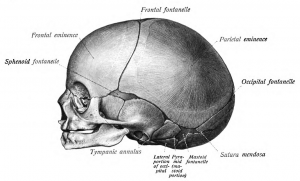Newborn babies are delightful, and delightfully weird sometimes. In your childbirth class, you may have seen videos of babies with cone-shaped heads! When you hold your new baby, you’ll soon notice a soft spot on top of their head. Why are babies’ skulls so strange?
Skull Bone Structure
The human skull isn’t one big, dome-shaped bone. It’s actually made up of multiple bony plates that fuse together over time.
Birth is notoriously a tight squeeze to get a full-term baby through the birth canal. It’s helpful for both mother and child to have as much flexibility as possible. An unfused skull is a major advantage for labor and birth. Higher concentration of cartilage (instead of all hard bone), and skull plates with a little room to shift means that baby’s head can safely squeeze a little bit to make it out more easily.
If your baby is born with a somewhat elongated or cone-shaped head, don’t worry! It’s normal, and the bones will relax back into photo-ready roundness in a few days or weeks. (And you’ll probably find your baby to be the cutest in the world no matter what shape the head is!)
Why Is My Baby’s Head Pulsing?
Did you notice a flicker of movement on top of your baby’s head, like a pulse? Yep, that’s the fontanel — or one of them. Your baby is born with two “soft spots,” places where the skull bones haven’t closed up yet. You may find this to be a tender part of newborn fragility, or a little freakish.
The posterior fontanel on the back of your baby’s head is smaller, and closes in a couple of months. The anterior fontanel, on top of the skull, can be about 2 inches end-to-end, and it may not completely disappear until your child is almost 2 years old!
Fontanels are important for normal development. They gave your baby’s skull bones room to shift a little during birth. Once your baby’s out, the extra space makes room for a rapidly growing brain.
Treat your baby gently, of course, and never shake a baby, but you also don’t need to worry too much about a soft spot. There are still tough membranes to protect the brain.
A fontanel can also provide critical information on your baby’s health. A bulging soft spot can be a sign of dangerous brain swelling. A sunken fontanel is a red flag for dehydration. These signs are rare, and you shouldn’t rely on a fontanel to monitor your baby’s health, but it’s good to know the signs.
Help! My Baby’s Head Is Flat
The Back to Sleep campaign, advising parents and caregivers to lay babies on their backs every time, has made significant progress in reducing the rate of SIDS. One minor drawback is that using the same sleep position every time, with a malleable, soft skull, can lead to a flat spot on your baby’s head.
A condition called torticollis (basically, a tight muscle in the neck) can make it more comfortable for babies to turn their heads in one direction. This can also cause skull flattening, or positional plagiocephaly, to use the medical term.
Your doctor may recommend gently turning your sleeping baby’s head to his less preferred side to help treat both the torticollis and the flat spot. Additional tummy time during the day can also lessen the amount of time your baby is pressing on a flat spot on the back of the skull. If you like babywearing, this may be a helpful technique to give a flat spot time to round out, too.
If position modifications like these aren’t helping, your pediatrician may recommend a special headband or helmet to encourage your baby’s skull into a rounder configuration.
In any case, try not to get too concerned about a small flat spot. If nothing else, when hair grows in, skull shape is going to be much less noticeable, anyway. Enjoy the incredible smell of your baby’s head, and take a moment to be amazed at the skull development happening underneath that peach fuzz.
How big should a baby’s skull be at birth?
As Joan MacDonald previously published in The Pulse (see here), The circumference of the average newborn’s head is between 13 and 14 inches, generally reaching 15 inches by the end of the first month. Because boys tend to be larger than girls, they tend to have slightly larger heads at birth, but the difference is usually less than an inch.

